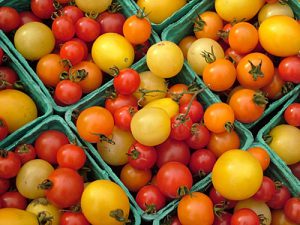What the latest research actually says (and doesn't) about organic
 Photo Credit: TumblingRun
Photo Credit: TumblingRun
Precise analysis of scientific articles isn’t always easy and almost never quick. Today’s media has much to report on and respond to, and increasingly, corners get cut in taking the time to get the news out in the most accurate way. A new journal article published in Science Advances highlights many areas where organic agriculture excels: higher biodiversity, improved soil and water quality, greater profitability, and higher nutritional value. But much of the current media coverage focuses less on the content of the paper and more on a few out of context quotes, and the guarded title of the article, “Many shades of gray—The context-dependent performance of organic agriculture”.
The actual language of the full article emphasizes the multitude of benefits of organic, while underscoring areas where more research is needed. Several misleading media articles have been sensationalized and are headlining a phrase in the study stating that “organic agriculture cannot be the Holy Grail for our sustainable food security challenges.” These reports miss the main point of the article, which can be summarized by another equally compelling quote from the researchers in the final section of the paper: “we conclude that organic agriculture offers many benefits and could be an important part of a suite of strategies to improve the sustainability and equity of our food system.”
We all have an incredible amount of information to absorb, and it’s critical that we get the most accurate facts in order to make the most informed choices in our daily lives. The Organic Center is here to help. The Center is a trusted, accurate, and in-depth resource for individuals interested in diving beyond the headlines and into the facts.
Let’s look now at what this latest research is really about. The Center has done a careful review of the work; here are the actual findings of the study:
 Photo Credit: Janice Cullivan
Photo Credit: Janice Cullivan
Biodiversity
The study authors examine several impact areas of organic, and find that many show significant benefits when organic practices are employed. When they look at biodiversity, for example, they state “the benefits of organic management for biodiversity of wildlife on farmland are clear, with a typical increase in organism abundance of 40 to 50% across different taxa.”
Soil Health
They find that soil benefits from organic practices. They note that organic farms have higher organic carbon content, reduced soil erosion, higher soil health and fertility parameters, and higher soil fauna abundance. The authors also tackle a common misconception about organic farming in comparison with conventional no-till farming, showing that the same proportion of organic farmers use reduced-tillage as conventional farmers.
Climate Change
The study explains that most organically managed crops put out lower N2O and total greenhouse gas emissions per unit area. Organic is also more energy efficient (primarily because of the ban on synthetic fertilizers), and improves soil carbon sequestration. However, the authors note more research is needed on the climate impacts of carbon sequestration, and that lower yields in organic can reduce these benefits when analyses are conducted on a per-yield-output basis.
Water Quality
 Photo Credit: Faungg
Photo Credit: Faungg
Organic agriculture does not use synthetic pesticides, and typically employ integrated pest management in combination with materials that are less harmful to the environment, so can help prevent negative impacts on native species and preserve the quality of drinking water.
Nitrogen and phosphorus leaching is also an important aspect of water quality. While the authors point out that “on average, N leaching per unit area in organic agriculture appears to be lower,” they go on to note that further research is needed, as variation in N runoff data is high. They also call for more research examining the impact of organic management on phosphorus runoff, as there are a limited number of studies examining this issue.
Water Use
Because organic management results in soils better able to hold water and with higher water infiltration rates, the authors suggest that organic farming “can lead to higher yields and water use efficiency under drought and excessive rainfall conditions and to lower water limitation of organic yields.”
Farmer and Farmworker Livelihoods
The authors show organic farming is more profitable than conventional farming, because organic products receive a higher price premium, and production costs are similar between organic and conventional production. Organic also uses techniques that can “provide more stable yields and to be more resilient to extreme weather events”, and the organic price premiums can help buffer against price volatility. The authors also note organic can be especially beneficial for farmers in low-income countries because organic can help with “the organization of farmers in cooperatives, building of social networks, integration of traditional knowledge, providing training, and access to health and credit programs through the certifying and exporting agency.”
Unfortunately, when it comes to farm worker livelihoods, there is little research examining what role organic plays. The authors note that currently organic regulations do not include labor guidelines. While organic does tend to employ more individuals, more research is needed on the impact of organic practices on farm worker income.
 Photo Credit: USDA
Photo Credit: USDA
Farmer and farm worker health
The benefits of organic farming associated with farmer and farm worker health are highlighted in this study as “one of the most important advantages of organic management for farm workers.” Synthetic pesticides are banned from use on organic farms, and therefore prevent pesticide poisoning, which is estimated to cause a million chronic diseases and deaths per year.
Consumer health
On average, studies examining organic crops show they have higher levels of secondary metabolites, vitamins, and mineral nutrients than their conventional counterparts. However, there is a large amount of variability among studies, and the authors say more research is needed in this area. Organic also has consistent benefits to consumers in reducing dietary pesticide exposure. The impact of these benefits is context dependent, however, and may be more important in low-income or developing countries.
Consumer access
Unfortunately, the same price premiums that benefit farmers can cause organic food to cost more than conventional products, leading to reduced access for consumers. There is a large amount of variability across the sector, however, with some products having comparable prices, and others showing up to a 60% price increase for organic. There are several techniques consumers can use to have access to organic at a lower cost. For example, the authors note that organic Community Supported Agriculture shares “can provide considerable cost savings to consumers, even compared to conventional produce.” Additionally, as research on organic methods increases, tools will be available for farmers to help them reduce production costs – a reduction that could then be passed on to consumers.
Yields
Yields output and stability are an area where more research is needed to ensure that organic producers can employ methods resulting in yields comparable to conventional yields. The authors note because organic farmers use organic soil amendments and more diverse crop rotations they can experience higher stability in yields over time, but they are also prone to pest and weed surges. Currently, many organic farmers lack the tools they need to ensure stable high-output yields, but as more research details best practices this yield gap is shrinking.
Scaling-up Organic
 Photo Credit: Mark Goebel
Photo Credit: Mark Goebel
In addition to examining the costs and benefits of organic, the authors also detail ways for scaling up organic, and improving yields. For example, they note that many organic farms are currently located in marginal areas, while large-scale conventional farms are located in areas with prime fertility. If the scale of organic increased to encompass some of these high-fertility areas, we might see a dramatic increase in organic yield. Research focused on breeds that are optimized for organic farming would also help to increase organic yields. Ninety-five percent of current crop varieties have been developed for high-input conventional management, and may not be well suited for organic systems. It is also important to think about nutrient availability as we consider scaling up organic systems. Currently, many organic farms rely on nutrient inputs from conventional farms, so an analysis of alternative nutrient sources, including biological fixation from legumes, would be critical as conventional farms became less abundant.
Research Needs
The study also includes a section about knowledge gaps and areas where additional research is needed, including yield stability, soil erosion, pesticide leaching, water use, farm wages, labor pesticide exposure, and consumer prices. They also cite the need for additional research on organic systems in low-income countries, identification of factors that drive the range of organic performance, and the environmental performance of organic agriculture per yield-output.
Conclusion
In the final section of the paper, the authors provide recommendations for how organic can amplify its many benefits. Specifically, they recommend more research on organic-specific crop varieties, continued focus on incorporating environmental best practices and labor rights into the organic standards, additional research and extension services on organic best practices, continued development of domestic organic markets and certification, subsidies for organic farmers, coupling organic and fair trade labels, and improved access of organic for low-income consumers.
The researchers conclude by showing that organic has had positive impacts on all of agriculture, noting that “the influence of organic agriculture extends beyond the ~1% of agricultural land it covers at present. Many conventional farms have, in recent years, increased the use of organic practices such as conservation tillage, cover cropping, or composts.”


